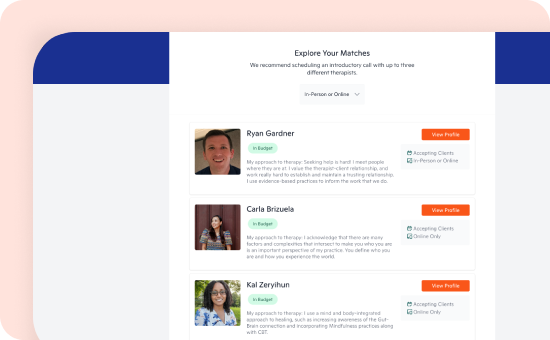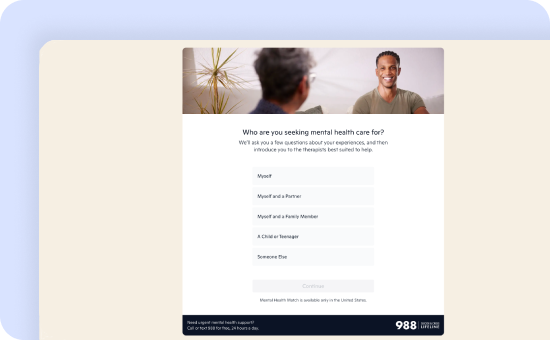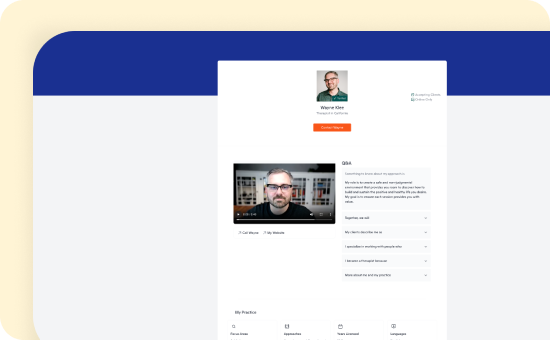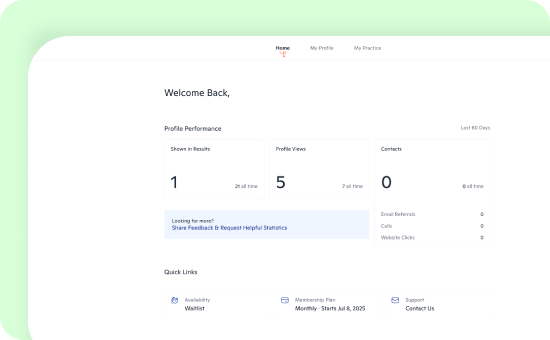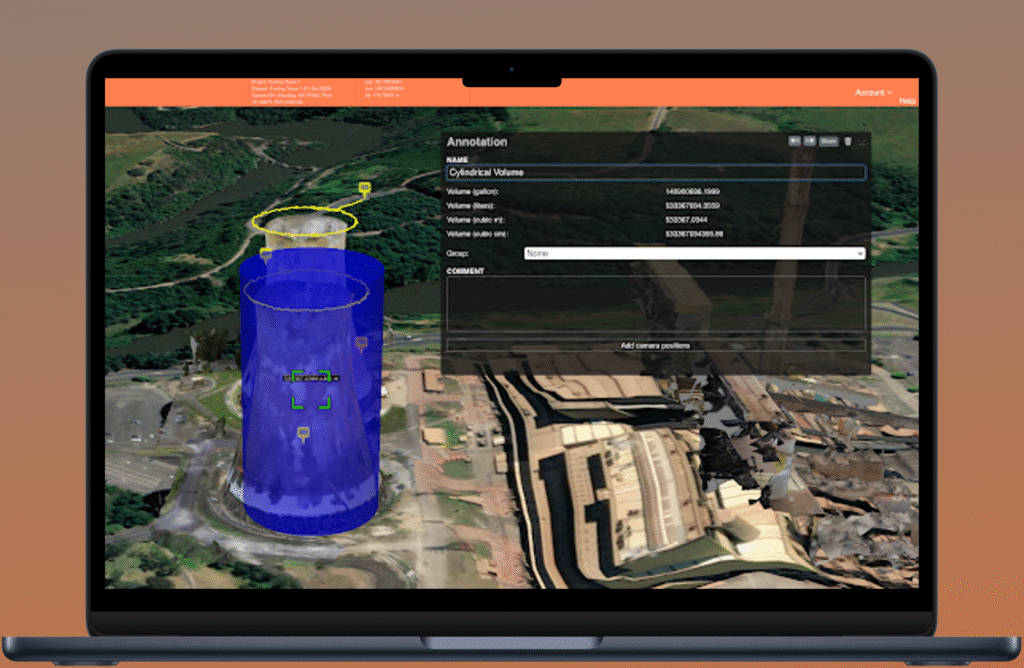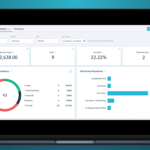Esketchers developed an intelligent platform to streamline access to mental health care across the United States. The platform matches individuals with licensed therapists based on personalized criteria such as mental health needs, budget, identity preferences, therapeutic approach, and geographic location, including state and neighborhood-level filtering. By guiding users through a simple questionnaire, it recommends the most compatible therapists, simplifying what is often a complex and overwhelming process.
Marketplace Connecting People to The Right Therapist
Marketplace Connecting People to the Right Therapist
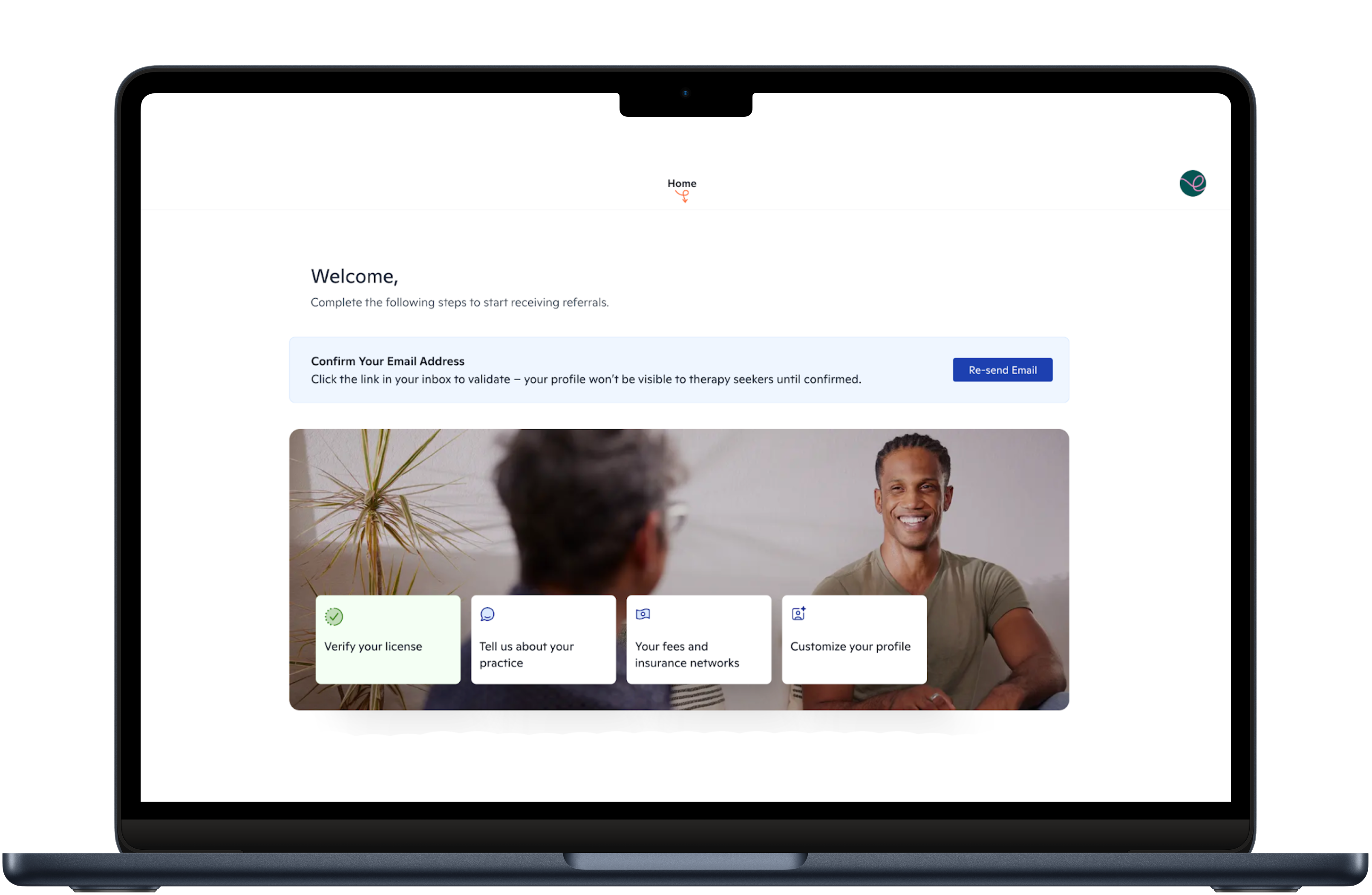
Problem
Finding the right therapist is one of the biggest barriers to mental health care. Endless directories leave people overwhelmed and unsure of whom to trust or whether a therapist fits their needs. This often leads to delays, mismatches, or people giving up. There was a clear need for a guided, user-friendly solution that matches individuals with therapists based on personal, clinical, financial, and location-based compatibility, including filters by state and neighborhood.
Solution
It offers a guided, algorithm-driven solution to help individuals connect with the right therapist, removing the guesswork from a typically overwhelming process.
Use Cases
Team
Services We Offered
Market Specifics
Deliverables
Client Goals
Our client wanted to build a platform that makes finding mental health support as simple and stress-free as possible.
Smart Therapist Matching
Create an intuitive, user-friendly experience that matches individuals with the right therapists based on personal needs, mental health goals, identity preferences, budget, and location (state, city, and neighborhood).
Automation
Reduce the manual effort involved in searching for therapists by automating the matching process through a guided questionnaire and smart filtering.
Accessibility And Inclusion
Ensure the platform supports people from diverse backgrounds, offering filters for race, gender, identity, and more to promote better therapeutic connections.
Scalable Infrastructure
Build a platform that can handle a growing number of users and therapists while maintaining speed, reliability, and ease of use.
Empowering Users
Help people take charge of their mental health journey by providing clear guidance, trustworthy therapist options, and a frictionless way to start therapy.
Support For Providers
Equip therapists with tools to manage their profiles, intake forms, and client connections, streamlining their workflow and supporting practice growth.
Target Audience
Therapy Seekers
Individuals seeking a private, personalized, and efficient way to find licensed mental health professionals that fit their needs.
Therapists
Licensed providers aiming to connect with well-matched clients and grow their practice.
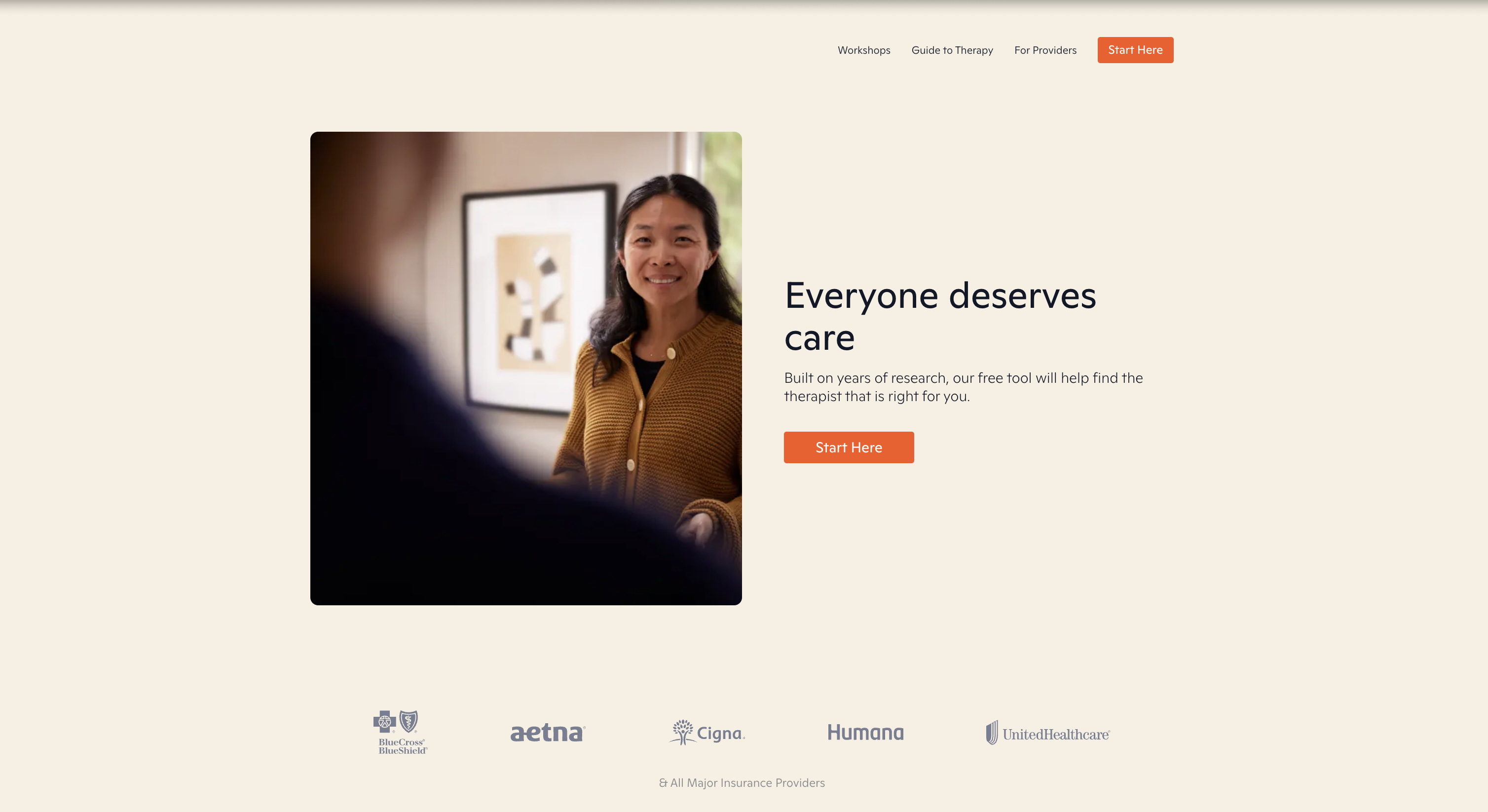
Core Features
Smart Matching
Users take a short questionnaire. The system recommends therapists based on clinical fit, budget, and personal preferences.
Advanced Filters
Search by location, price, identity (like race or gender), therapy style, and specialties to find the right match.
Therapist Profiles
See detailed bios with credentials, experience, pricing, and therapy approach for easy comparison.
Direct Booking
Message therapists or request sessions through the platform. Some support instant booking and intake forms.
Therapist Dashboard
Therapists manage profiles, availability, leads, and client focus areas. Can list insurance and sliding scale rates.
Resource Library
Optional content to help users start therapy, understand different modalities, and improve mental health awareness.
Additional Features
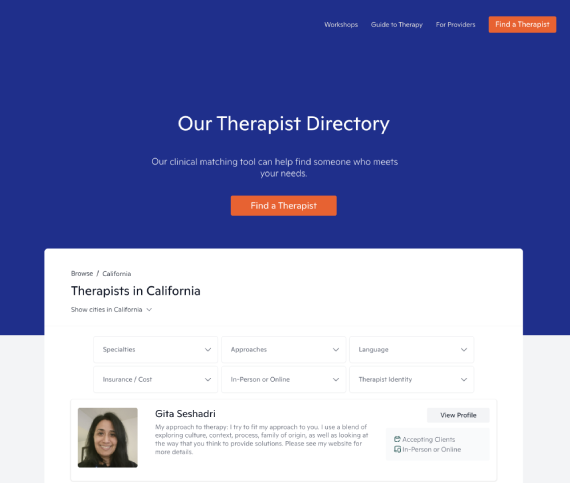
Nationwide Coverage
Licensed therapists available in all states, for in-person or virtual sessions. Location-based matching ensures relevance.
SEO-Friendly Platform
Fast-loading, structured, and optimized with SSR, CDN, and caching, designed to help people quickly find the right support when they need it most.
Expert Content
Articles and workshops created by licensed therapists offer trustworthy guidance and practical tips for navigating mental health challenges.
Secure Messaging
Encrypted chat lets users connect with therapists privately and safely.
Clear Pricing
Profiles show insurance, rates, and sliding scale availability upfront.
Provider Insights
Therapists see profile views and lead activity to grow their practice.
Achievements
Thousands of Successful Matches
The platform has helped thousands of people finally find a therapist who gets them, whether they were starting therapy for the first time or looking for someone new who truly fits.
Therapists Growing Their Practices
Therapists have used the platform to meaningfully grow their caseloads with clients who align with their specialties, values, and availability, without spending hours on marketing.
Nationwide Reach
The platform now supports connections in all 50 states, giving both therapists and clients access to a broader, more diverse community.
High-Intent Engagement
People don’t just browse, they act. The platform’s simple and intuitive flow leads to higher follow-through rates and better outcomes for both sides.
Recognized by Major Media
Being featured in outlets like The New York Times and Forbes has helped build trust with users and elevate the visibility of therapists on the platform.
Tech Stack
Front-End
Back-End
Deployment Strategy
Quality Assurance Strategies
To ensure the delivery of a reliable, user-friendly, and secure mental health platform, we implemented a comprehensive Quality Assurance (QA) approach throughout the development lifecycle. These strategies were essential in maintaining trust, performance, and functionality across all user journeys—both for clients and therapists.
Early QA Involvement (Shift Left Testing)
Our QA team was embedded from the start—collaborating with developers and product leads during planning and design. This allowed us to anticipate edge cases, validate requirements early, and catch potential issues before they reached production.
Real-World Device and Browser Testing
Given the platform’s wide user base, we performed extensive cross-browser and cross-device testing to ensure consistency across mobile, tablet, and desktop—on all major browsers. This was key to delivering a smooth experience, regardless of how users accessed the platform.
User Acceptance Testing (UAT) with Therapists & Clients
Before going live, we ran UAT with real therapists and users to validate the platform’s matching flow, messaging system, and profile management. Their feedback helped us fine-tune usability and address any friction points that weren’t caught during internal testing.
Automated Testing in CI/CD
We integrated automated testing within our CI/CD pipeline to catch bugs and regressions instantly with every code change. This ensured we maintained quality even as the platform evolved and new features were rolled out.
Focused Security & Data Privacy Checks
Given the sensitivity of mental health data, we emphasized security testing—including input validation, role-based access controls, and encrypted communication—to ensure HIPAA-conscious development and protect user information
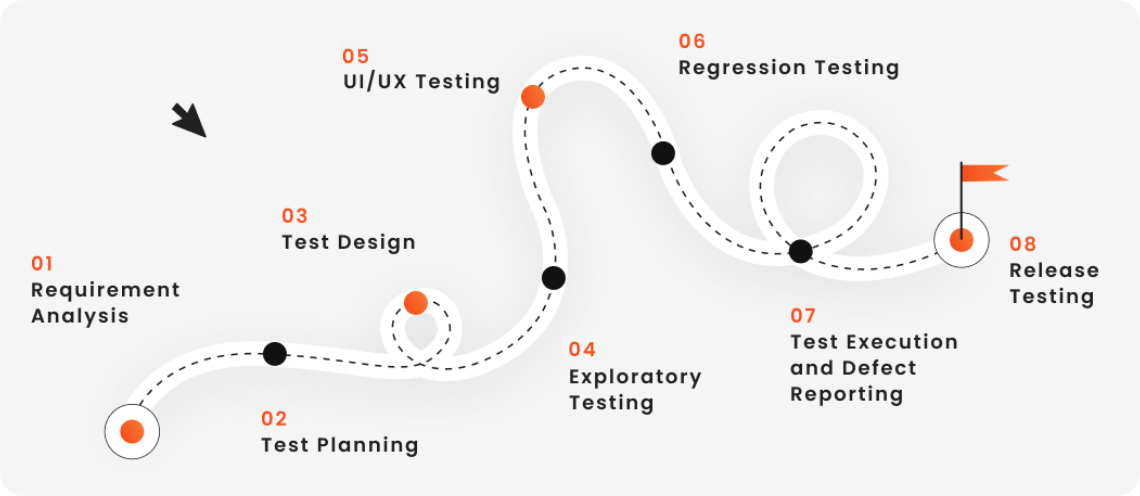
Testing Methodology
To deliver a seamless and secure experience for both therapists and clients, we applied a thoughtful and systematic testing methodology throughout the development lifecycle. Every test phase was rooted in real-world user behavior, ensuring the platform not only functioned flawlessly but also built trust in an emotionally sensitive space.
Requirements Analysis and Planning
- We collaborated with stakeholders to define clear, testable criteria for core features like therapist-client matching, secure messaging, and intake forms. Each feature was broken down into manageable components, with a focus on user flow clarity, data privacy, and emotional comfort during onboarding and interaction.
Integration Testing
- The platform relies on multiple interconnected systems, matching algorithms, scheduling tools, messaging features, and therapist profile management. We validated the flow between these components to ensure smooth transitions and consistent data handling across the entire user journey.
End-to-End Testing
- We simulated full workflows from both therapist and client perspectives, account creation, profile setup, match recommendations, communication, and session follow-ups. These scenarios helped us fine-tune edge cases and maintain a frictionless experience across all user types.
Cross-Platform and Browser Testing
- The platform needed to be accessible to a wide audience, many of whom use mobile devices. We rigorously tested functionality and responsiveness across all major devices and browsers to ensure a consistent, intuitive experience regardless of how users accessed the platform.
Security and Privacy Testing
- Given the highly personal nature of mental health data, we prioritized security testing. This included validating encrypted communication, role-based access control, secure data storage, and compliance with healthcare data privacy standards.
Regression and Load Testing
- As the platform scaled and new features were introduced, we conducted regular regression testing to safeguard existing functionality. We also performed load testing to ensure the platform could handle spikes in traffic, particularly during national mental health campaigns or therapist onboarding waves.
Why we used this particular methodology?
Prioritization
Key features like AI-powered document generation and visa petition preparation were prioritized to meet immediate user needs. Focus was placed on delivering critical functionalities first, ensuring a smooth and timely launch.
Defect Management
Defects were tracked using Notion, categorized by severity, and resolved efficiently. Regular regression testing ensured stability, and clear communication between QA and developers expedited issue resolution.
Test Coverage
Comprehensive testing included integration tests for workflows and end-to-end testing for real-world scenarios. Cross-platform and load testing ensured performance and reliability.
Security Standards
Strict security measures safeguarded sensitive user data, including vulnerability assessments and secure cloud storage. Compliance with data protection laws and continuous monitoring ensured robust data security.
Project Management
Agile Methodology
Used Agile methodology to allow flexible planning and adapt to changes quickly.
User Feedback
Collected user input regularly and made improvements based on it.
Team Collaboration
Developers, designers, and testers worked together closely.
Tools Used
Managed tasks with Notion and communicated through Slack and Zoom.
Scrum Process
Held daily check-ins, planned sprints, and reviewed progress regularly.
Scrum Planning
Carefully schedule tasks, assign resources, and set clear milestones to meet deadlines.
